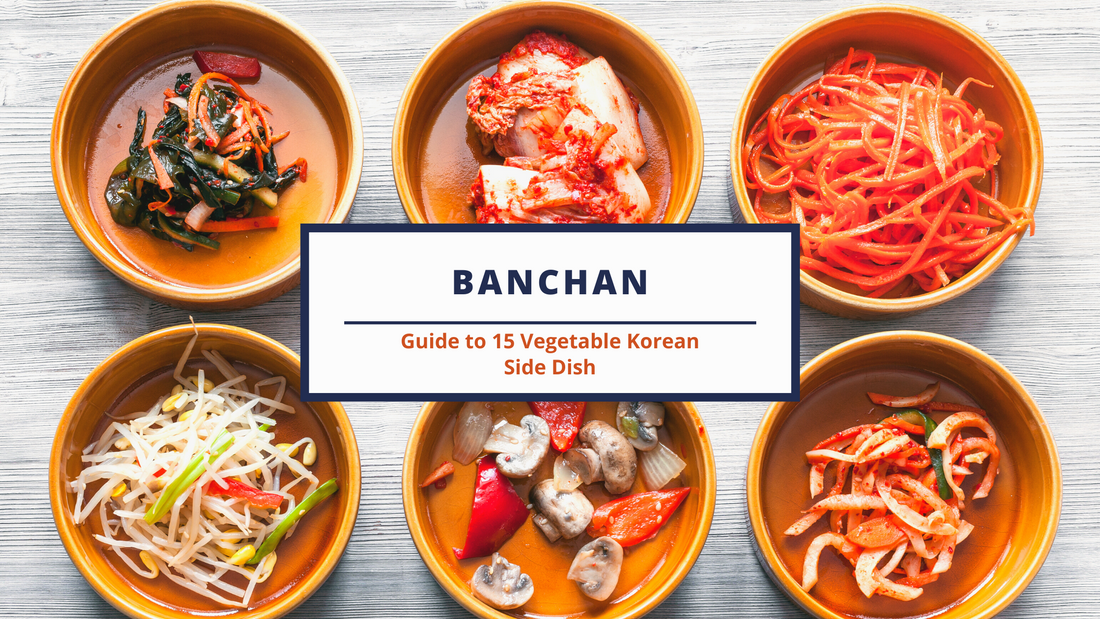Banchan, 반찬 in Korean, is a collective word for Korean side dishes usually served with rice. These smaller bites come in all sorts of variations, but today we want to look at the vegetarian options made out of vegetables. Let’s dive into this colorful culinary world, shall we?
Where Does The Tradition Of Banchan Come From?

Most of banchan are fermented foods, meaning that fresh produce has been pickled for a certain amount of time to increase the storage life of the ingredients. This tradition originated in the need to safeguard crops over the cold winter month where no fresh food could be grown. Koreas agriculture mainly focused on agriculture, not livestock, meaning the most available products were grains and vegetables. Being surrounded and isolated from mountains on all sides, it became necessary to store food for long periods in the Korean countryside. Spices like gochujang were and are still used to enhance the flavor of produce. Kimchi is an excellent example of the enrichment caused by fermentation and seasoning. Other banchan are seasoned with fermented soy products, herbs, and perilla oils.
How Are Korean Meals Composed?

Korean meals are called bansang (반상) and consist of cooked rice, called bap (밥) in Korean, a soup, gochujang, a Korean red chili pepper paste, and Kimchi. Kimchi is one of the side dishes that you will find included in nearly every single Korean meal. It is made out of cabbage, marinated in a paste made of gochugaru, the flakes of the Korean red chili pepper, vegetables, and stock. Usually, it contains fish sauce as well, but there are vegetarian options out there too.
Depending on how many side dishes are added to the bansang, the table setting has a different name. It varies from three to twelve cheap bansang. The 12 cheaps (십이첩) bansang was used in Korean royal cuisine. There were even instructions for how the table had to be set, following hundred-year-old traditions.
Among all the banchan, kimchi stands out as the quintessential example of how fermentation can elevate a simple ingredient into a culinary masterpiece. This iconic dish typically features napa cabbage, radishes, or other vegetables, which are meticulously seasoned with a blend of spices, including gochugaru (red pepper flakes), garlic, ginger, and more. These ingredients undergo a transformative fermentation process, resulting in a tangy, spicy, and umami-rich flavor profile.
Diverse Fermentation Techniques
Beyond kimchi, banchan includes an array of dishes that showcase the diversity of fermentation techniques and seasonings. Some banchan are seasoned with fermented soy products like doenjang (soybean paste) or ganjang (soy sauce), which infuse the dishes with depth and complexity. Others incorporate herbs and perilla oils, providing a unique aromatic dimension to the array of flavors.
Is Banchan Shared?
Yes, banchan are shared and therefore placed in the middle of the table. Korean meals are often composed of a social event where significant portions of a plate are prepared and placed on the table. Each person has an individual bowl in front of them and chooses what they want to eat from the dishes on the table. But now it’s time for us to take a closer look at the individual dishes and all their differences.
What Are The Most Common Banchan In Korea?
Kimchi
In the first place, we must, of course, mention Kimchi. This traditional Korean side dish can be found at the side of every Korean meal that you order in restaurants, maybe with the exception of dessert. Unless… No, but for real, the tradition of making Kimchi reaches back to the Silla Dynasty (57 BC-AD 935), where napa cabbage was coated in a marinade of Korean radish mixed with Gochugaru (Korean chili flakes) and added seasonings like garlic, ginger, spring onions, and jeotgal (salted seafood) and placed in onngi, a traditional earthenware pot that was covered in snow during the wintertime. The cabbage would ferment for the whole winter season and then be eaten in spring. Nowadays, a few Kimchi farms are left that prepare it the traditional way, but there are also Kimchi fridges available. If you want to make it yourself, you can as well put the cabbage in BPA-free plastic containers and store it at room temperature until it starts fermenting. Then place it in your fridge, and you are good to go. Some Korean stores also sell small onngi that you can put in your fridge. The only thing you might want to know is that Kimchi has a specific smell once it starts fermenting. But nothing you can’t get used to.
Namul

Namul (나물) are different kinds of steamed vegetables like spinach, daikon, zucchini, green bean sprouts, or Korean bellflower that are seasoned with hot pepper, garlic, salt, and sesame oil. They are very rich in their flavor and taste amazing when you add them to your rice.
Bokkeum
Bokkeum (볶음) is a side dish that is stir-fried and topped with a sauce. Multiple banchan are prepared this way, for example, Buseot bokkeum (버섯볶음), which are stir-fried mushrooms like oyster mushrooms. Despite the name, they are vegetarian and stable in vegetarian cuisine for their great taste and thinness, which makes them easy to cook. If you would like to learn how to make this banchan click the link below to watch Maangchi teach you how to make the perfect Buseot bokkum.
Sigeumchi-Namul
Sigeumchi-namul (시금치나물) is a simple banchan made out of blanched spinach, keeping it perfectly soft but still a bit crispy. The spinach is seasoned with soy sauce, garlic, and sesame oil. Not a whole lot of ingredients but a whole lot of taste, that’s for sure!
Jorim
Jorim (조림) is a banchan that is being simmered in broth until it has reduced down and absorbed into the other ingredients like Tofu. The broth is seasoned with diluted soy sauce, garlic, sesame oil, and green onion. The version that includes Tofu is called Dubu-jorim (두부조림).
Sukjunamul-Muchim
Sukjunamul-muchim (숙주나물무침) is a side dish made out of mung bean sprouts. They are being cooked and then seasoned with garlic, green onion, salt, sesame seeds, and sesame oil. You mix all your ingredients, and that’s it. Super simple right?
Jeon

Jeon (전) are pan-fried, pancake-like banchan. They can be made with a variety of ingredients. If you happen to have leftover Kimchi and it is already a bit too ripe for eating it just like that, you can make Kimchijeon (김치전). The Kimchi is included in a batter and pan-fried. It tastes delicious. Another vegetarian version is Pajeon (파전). The main ingredient here is scallions coated in a batter consisting of egg, wheat, and rice flour.
Oi-Muchim

Oi-muchim (오이무침) is a spicy cucumber side dish. Sliced cucumbers, onions, green onions, and garlic are seasoned with soy sauce, gochugaru, sesame oil, sesame seeds, and sugar mixture. It’s super easy but a crowd-pleaser. You can also alternate the spiciness by adding more or less gochugaru.
Bok Choy Doenjang Muchim

Bok Choy doenjang muchim (청경채 무침) is another vegetable banchan that can substitute Kimchi if you don’t like it or can’t find the napa cabbage anywhere. The bok Choy is blanched, similar to the Sigeumchi-namul but has a different composure of flavors. It is seasoned with garlic and green onion. The special ingredient here is doenjang, a fermented soybean paste. It is very salty and rich in flavor and adds a specific something to this side dish. Gochujang, to add spice and sugar to round out the flavor. Sesame oil adds a nutty note, and then it is time to mix. It only takes two minutes for the bok choy to be soft enough, and then we can combine all ingredients. Sesame seeds are added, and we are done with another vegetable banchan.
Which banchan is your favorite so far? Let us know in the comments down below!
Gyeran-Jjim
Gyeran-jjim (계란찜) are steamed eggs. This side dish is light and fluffy, similar to custard, and topped with scallions and toasted sesame seeds. Gyeran-jjim can be steamed, double-boiled, or boiled. The eggs are sieved and mixed with water until the mixture reaches a well-blended, creamy consistency.
Musaengchae
Musaengchae (무생채) is a salad made of white Korean radish. The radish is chopped up into matchsticks and seasoned with salt, vinegar, hot pepper flakes, sugar, garlic, green onion, and sesame seeds. After mixing all ingredients together, the banchan is ready to be served alongside other side dishes.
Algamja-Jorim

Image credits: mykoreankitchen.com
We had all kinds of vegetables already, but potatoes are still missing. Algamja-jorim (알감자조림) are braised baby potatoes that make a great banchan. The potatoes are added to a pan with some oil and covered with a lid over medium heat. Make sure to give them a shake once in a while, so they don’t stick to be bottom of the pan and cook evenly. Once you can easily pierce them with a wooden stick, it’s time to add some soy sauce, rice syrup, and garlic. Make sure to give it a good shake, so everything is coated in the sauce. The potatoes will start to get wrinkles at this point. But don’t worry, they are not aging quickly; they are more delicious this way. Over low heat, this mixture is being braised. Once the sauce has reduced, you can plate your banchan and serve it.
Gamja Salad
Gamja salad (감자샐러드) is a Korean style potato salad. You heard right; we are staying on the potato topic. First off, you need to boil potatoes. Then slice up a cucumber but leave out the middle part with the seeds in it as it is too moist and will make the salad soggy. But it’s delicious on its own, so don’t throw it away! The outer part of the cucumber is cut into matchsticks and then diced. Now you add a good amount of salt. This will make the cucumber sweat so you can squeeze out excess water. Your cucumber will stay fresh and crispy inside the potato salad like this. Boil eggs until they are complex, peel them, then separate the egg yolk and the egg white. Chop up the white part while sieving the yolk to a fine powder. Once the potatoes are boiled super soft, you must mash them up and add the egg yolk powder. Then mix in your other ingredients. Season it with white pepper, rice syrup, and mayonnaise. And you’re all done!
Geomeun-Kongjorim

Our second last banchan for today is Geomeun-kongjorim (검은콩조림). Braised black beans. Another effortless yet delicious side dish that you can easily make at home. The only time-intense part here is that you have to soak your black beans in water for 10 hours if you buy them dried. After that, you boil the beans. After a while, the water will reduce. Cut up garlic and add it to the beans and soy sauce, and dark brown sugar. Lastly, add vegetable oil and stir. Now it needs to be cooked for 10 minutes over low heat to melt the sugar. The very last step is to add rice syrup to give it a delicious shine.
Dubu-Ganjeong
Dubu-ganjeong (두부강정) is our last banchan. This side dish is sweet and crunchy Tofu, made out of firm Tofu fried and then coated in a sauce of tomato ketchup, rice syrup, and gochujang. It is topped with fried pumpkin seeds.
You now got to know a huge variety of Korean side dishes, banchan. These have been served in the royal cuisine of Korea for hundreds of years and are stable in Korean tradition. Please let us know which one of these side dishes you have to try! Or maybe you have already tried some before. Let us know in the comments down below.
















